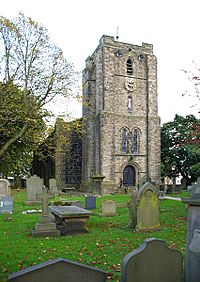St John the Evangelist's Church, Worsthorne facts for kids
Quick facts for kids St John the Evangelist Church, Worsthorne |
|
|---|---|

St John the Evangelist's Church, Worsthorne,
from the west |
|
| Lua error in Module:Location_map at line 420: attempt to index field 'wikibase' (a nil value). | |
| OS grid reference | SD 876,324 |
| Location | Church Square, Worsthorne, Lancashire |
| Country | England |
| Denomination | Anglican |
| Churchmanship | Central |
| Website | St John the Evangelist, Worsthorne |
| History | |
| Status | Parish church |
| Dedication | John the Evangelist |
| Architecture | |
| Functional status | Active |
| Heritage designation | Grade II |
| Designated | 17 December 1968 |
| Architect(s) | Lewis Vulliamy W. B. Colbram Austin and Paley |
| Architectural type | Church |
| Style | Gothic Revival (Early English) |
| Groundbreaking | 1834 |
| Completed | 1902 |
| Specifications | |
| Materials | Sandstone, slate roofs |
| Administration | |
| Parish | St John the Evangelist, Worsthorne |
| Deanery | Burnley |
| Archdeaconry | Burnley |
| Diocese | Blackburn |
| Province | York |
St John the Evangelist Church is a special building located in Church Square in the village of Worsthorne, Lancashire, England. It's an active Anglican church, which means it's part of the Church of England. It serves as a parish church for the local community. This church is also recognized as a Grade II listed building, meaning it's an important historical and architectural site that needs to be protected.
Contents
The Church's Story: How It Was Built
The church was first built between 1834 and 1835. It was designed by an architect named Lewis Vulliamy. Later, in 1894, a part of the church called the chancel was added by W. B. Colbram.
Changes Over Time
More changes happened in 1903 and 1904. Architects from Lancaster, Austin and Paley, built the tall tower at the west end. They also removed some old rooms there and added more seating.
Wealthy families from the area, like the Hargreaves and Thursby families, helped pay for these building projects. These families owned local coal mines. In 1843, the area around the church became its own special district.
Inside the Church
In 1902, some upper seating areas, called galleries, were taken out. The plasterwork inside the church was removed in 1929. In 1973, the inside of the church was changed again. Rooms were created at the west end by adding a new floor.
What the Church Looks Like
St John's Church is made from sandstone and has slate roofs. Its style is called Early English, which is a type of Gothic Revival design.
Key Parts of the Building
The church has a main area called the nave with five sections. It also has a chancel and a tower at the west end. The tower has three levels, with the top two levels set back a bit.
The Tower's Details
The tower has special corner supports called pilaster-straps. The very top part, called the parapet, is also set back. At the bottom of the tower, there's an arched doorway. Five steps lead up to this door.
Next to the steps, there's a wrought iron handrail. This handrail was designed in 1979 by Brian Rourke. It has decorations that show the local industries from the past.
The middle part of the tower has small windows on each side. There's also a clock face on the west side. The top part of the tower has arched openings with louvred slats for the bells. It also has round shapes with quatrefoil designs.
Windows and Stained Glass
The main part of the church has shallow supports called buttresses between its sections. Each section has a large, tall window. The window at the east end has three equal tall windows. These windows, and the ones in the tower, have beautiful stained glass. The stained glass was designed by George Wragge in the 1930s.
Outside the Church Grounds
The churchyard is a special place. It contains the war graves of two soldiers from World War I. There is also a grave for a soldier from World War II. These graves remind us of people who served their country.
More to Explore
- Listed buildings in Worsthorne-with-Hurstwood
- List of ecclesiastical works by Austin and Paley (1895–1914)

